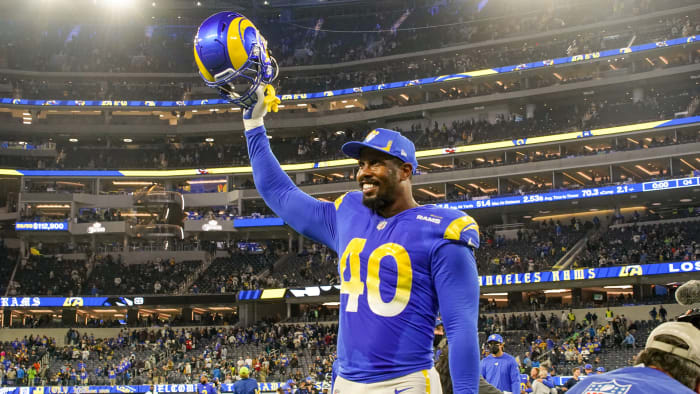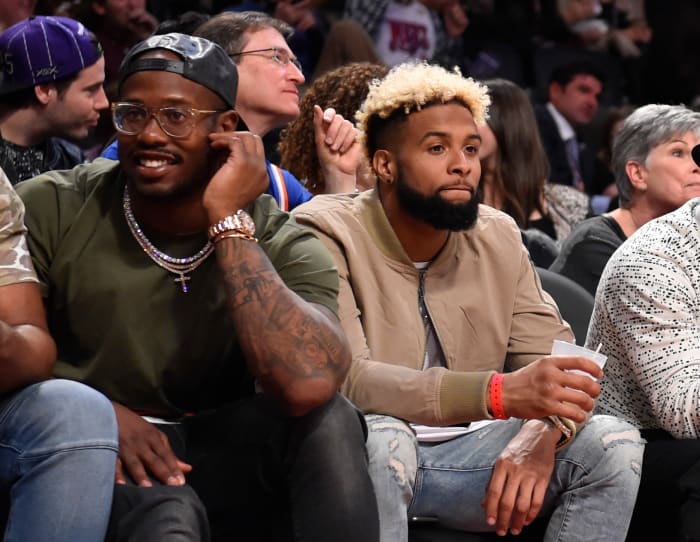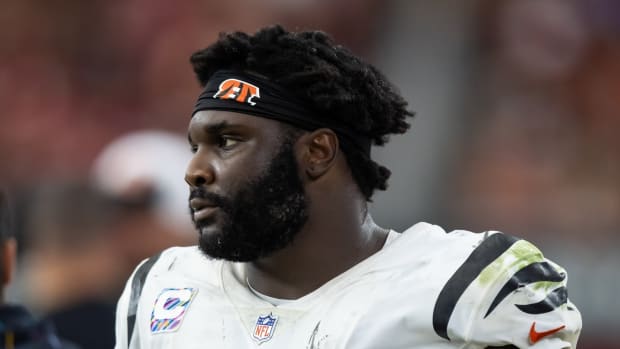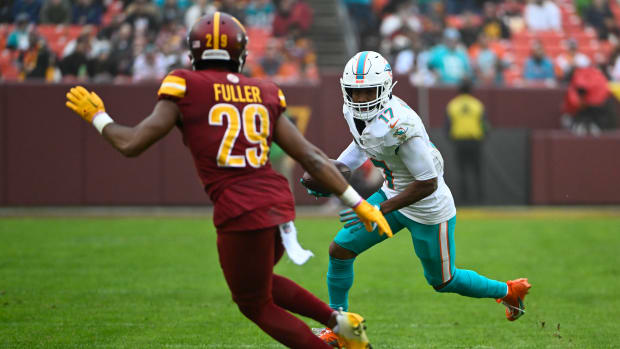Von Miller Is Dreaming Another Dream
Two friends and NFL superstars moved to Colorado Springs last offseason. They wanted to train together, prod each other and labor at high altitude so both could return to the rare air they reached during the 2015 season. Both were rehabbing from different injuries that had cast their respective futures into doubt. Both were playing for teams that held playoff aspirations, even long-shot Super Bowl hopes. And both were confronting the same question, which loomed like the mountains outside the window as they plotted twin, parallel comebacks: Could they return to peak form?
Von Miller was still a Denver Bronco. But the patella tendon he dislocated in his left ankle had cost him both time and shine. Memories of the championship run that vaulted him to superstardom had begun to fade. In the four seasons since Denver won Super Bowl 50—with Miller netting the game’s MVP honors—he remained an elite pass rusher, registering 14.5 sacks in 2018 alone. Still, that tally dropped to 8.0 in ’19, his second-lowest total in 10 seasons, the last of which he had missed in its entirety. The Broncos had not returned to the playoffs since their title.
Odell Beckham Jr. was still a Cleveland Brown. But the ACL he had torn in his left knee had cost him all but seven games in 2020. Memories of his spectacular ’15 with the Giants—96 receptions, 1,450 receiving yards, 13 touchdowns—had been replaced by a run of solid-but-no-longer-spectacular production after a trade to Cleveland.
Most weeks, the duo trained Monday through Saturday, often sweating for two or three workouts between sunrise and sunset. Almost every day, they wondered: Wouldn’t it be wild if, one day, somehow, some way, they played for the same team?
Maybe in Ohio, Miller wondered, daydreaming out loud.
“Don’t come to Cleveland,” Miller says Beckham told him.
Fortified, hopeful and aware that the daydream was more like a pipe dream, both reported to their respective training camps. They didn’t know that Miller would be traded to the Rams on Nov. 1, swapped for second- and third-round draft picks, shipped out of the only professional football home he had ever known. One night around that time, he had an actual dream, in which Beckham was featured prominently, the receiver winning Super Bowl MVP just like he had. But in his dream, Miller also felt elated, and while he would have expected to be happy for his friend, he couldn’t figure out why he was that joyful.
The Browns released Beckham a few days later. The Rams, at Miller’s urging, signed the wideout after he cleared waivers. Only then did Miller’s vision make sense. Only then did the true purpose of the weeks they spent beavering in the Rocky Mountains become clear.
“It’s time, man,” Miller says Beckham told him. “Time to put it all together.”
This is a story about Von Miller, about what happens after the pinnacle is ascended; about failing and falling; and, in a broader sense, about how the NFL is changing and his place in that change. But Miller’s story was never just about Miller, his staggering sack count, his accolades or the extension he signed after Super Bowl 50 that made him the highest-paid defender in league history. Just ask Beckham.
Instead, Miller’s story is encapsulated by the last 12 months, by who he lost and what he found, by two receivers he holds close to his heart and two Broncos legends who shaped his return to the pinnacle from which he’d slipped. “It’s a movie,” Miller says, and one that required a trip back in time. Miller aimed his football DeLorean to 2015 and early ’16, when a veteran team with an older quarterback went all-in on a title, its pursuit bolstered by a dominant defense and elite players slotted into important skill positions. That team—Miller’s Broncos—ran on late-season momentum, bloodied Tom Brady in the playoffs and delivered a Super Bowl title in honor of an important franchise figure who had fallen ill.
“It’s like I went to heaven, right?” Miller says. “And I’m trying to tell [Rams teammates] how pretty the golden brick road is, and how, once you’re there, it feels unlike anything you’ve ever felt.” He continued to emphasize that message as the NFC championship game, scheduled for Sunday in Los Angeles, drew nearer, and not in a mystical sense but in a practical one. He knew the Rams’ sordid recent history with the 49ers, the team that stands in the way of his return to the grandest stage in the NFL. He expects a physical contest, expects to deliver bruises and develop them. But he reminded the Rams, “If we play how I know we can, we’re going forward, to the same place, with the same kind of momentum.
“This season,” Miller adds, “feels just like that one.”
Miller considers himself a visionary, his nights filled with “crazy dreams” that combine to form the rough outline of his life. They’ve led to a vast range of pursuits, everything from raising chickens to moonlighting as a deejay to cradling the Lombardi Trophy, the connective tissue being that Miller considers each aim “pretty dope.”
He dreamt of Denver before the Broncos took him second in the 2011 draft. He dreamt of January football and made the playoffs in each of his first four seasons. He dreamt of apprenticing under a mentor and found one in fellow sack artist DeMarcus Ware. He dreamt of clashing with Brady and knocked the Patriots out of the postseason in the divisional round.
He even dreamt of taking snaps at quarterback—alas, proof that not all of his visions can be realized. The aftermath of Super Bowl 50 reinforced that notion for him, too, in ways Miller never anticipated as he terrorized Cam Newton and upended the Panthers, who had won 17 of 18 games before the Broncos bludgeoned them. Had the teams played a best-of-seven series to decide a champion, like in basketball or baseball, Miller says the Panthers would have won.
When the Broncos triumphed instead, Miller hopped on a golf cart and sped to various TV network sets. On the ride, he explained to Sports Illustrated how he had spoken the title into existence, how it represented the culmination of his life. It meant so much he lost track of his pants, but that’s another story. SI also followed Miller through the next spring. He partied with Lil Wayne, attended the NBA’s All-Star festivities and appeared on Saturday Night Live. He took 61 flights, flew more than 71,000 air miles, visited more than 25 U.S. cities (and Drake in Toronto), made 47 television appearances and competed on Dancing with the Stars.
The title and ensuing celebrity whirlwind combined to heighten his expectations; he would continue not just dreaming but living the exact life he had envisioned. Then reality stepped in. Miller endured injuries, the Broncos’ depth and talent level thinned through free agency and retirements, and both star and franchise had more losses (52) than wins (36) between the Super Bowl and the trade. Denver’s search to replace Peyton Manning continues.
As defeats mounted, Broncos coaches doubled all expectations, telling players to watch more film, lift more weights, withstand longer practices. The implication: They weren’t trying hard enough.
Still, Miller never considered leaving, never demanded a trade, never voiced any concerns, if he felt any deep down. He asked himself the same question on more than 1,000 mornings: What can I do to fix this? He tried explaining how it felt in football heaven, hoping he might re-create the same culture espoused by Manning, wideout Demaryius Thomas and Ware. “It’s hard to inspire players in that way when they haven’t tasted it,” Miller says. “It’s nobody’s fault; they don’t know, so it just falls on deaf ears.”
The same group that propelled Miller to a title—his parents, Von Sr. and Gloria; his brother, Vinsynzie (known as Vins); and his pass-rush coach, Chuck Smith; among others—helped motivate him when paradise morphed into perpetual struggle. “The thing about Von, he’s always optimistic,” Smith says. “He always thought they were a quarterback away.”
Still, as a 3–0 start to 2021 gave way to four-straight losses, Ware noticed an uptick in the frequency of Miller’s calls. Ware sensed an urgency, the product, he says, of “you have everything you want, fame, success, all that, and, all of a sudden, it’s on hold.” Miller told Ware he “finally realized” why Ware had pushed the Broncos as hard as he did in ’15, because Ware knew losing from his time in Dallas, and he knew how many factors needed to coalesce to form a legitimate run. Miller also asked: What’s it like to play for another team? “Change can be good,” Ware told him.
Do you think they’ll trade me? “No way,” Ware answered.
A deep thinker, Miller began considering how past events impact future outlooks. He saw this as a blessing, because it informed decisions and allowed for planning—and a curse, because it birthed anxiety and stress, and could warp perceptions of reality.
His: Miller had become the NFL’s version of Mike Trout, an elite talent stuck on a mediocre team. Was his peak already behind him?
In the weeks before the Nov. 2 trade deadline, Sean McVay hinted that the Super Bowl contender he took over in 2017 wasn’t done retooling. The hint was about as surprising as the sun rising high over Los Angeles. His Rams had dealt for Jalen Ramsey and Matthew Stafford, among others, in pursuit of their first championship since ’00. “Never say never,” McVay told reporters. Perhaps he meant: of course.
Around then, the Broncos began discussions with various teams over a previously unthinkable notion—trading the smirking face of their franchise, a star synonymous with where he starred. At least four franchises expressed initial interest, including the forever-retooling Rams. Los Angeles didn’t mind parting with draft capital; that’s general manager Les Snead’s well-established modus operandi. And when the Broncos offered to cover all but $700,000 of the $9.7 million owed to Miller, they had a deal.
Despite the questions he asked Ware, Miller maintains he never saw it coming. Not until he arrived at team headquarters on a Monday morning and was immediately summoned to the office of general manager George Paton. As they made small talk, Miller’s mind spun. “Damn,” he thought, “where am I going?”
“We’re going to trade you,” Paton answered, as if inside Miller’s head, “to the Los Angeles Rams.”
Miller thanked the general manager, left the office and paused in the hallway. He tried to collect himself but collapsed into sobs, his body shaking. It felt like a divorce. He said goodbye to teammates, then headed outside, where reporters stood, waiting for a statement. He started looking back, reminiscing, and just thinking about leaving prompted more tears.
“That’s all I ever knew,” Miller says. “No matter how bad things got, I would stick it out. Kind of like how Larry Fitzgerald was with the Cardinals. I’mma still be here.”
With more than two months of hindsight—and another appearance in a conference title game on deck—Miller insists he now looks back at that day, and that decision, with gratitude. Fact is, the Broncos aren’t positioned to contend. The Rams are. “In my heart, I’ll always be a Denver Bronco because of that,” Miller says. “Even on my way out, they were still thinking about what was best for me.”
Miller drove home from the facility for the final time. He had lived there for 10 years, almost a third of his life. He had grown up there, in that house, with the Broncos. Teammates had celebrated victories in his basement, which Miller nicknamed “Club 58” after his jersey number.
When Ware heard his friend had been traded, he knew where without having seen the news scrolling across the ticker. The Rams, with Ramsey and Aaron Donald and a host of solid defenders around them, made too much sense. At least, that is, for those who believed Miller had not slipped. That he could summon the wrecking ball from 2015 again.
He put that house on the market. Took a flight to L.A. He went to sleep one night with a 4–4 record and—as he noted at his introductory news conference—woke up 7–1 the next morning. Rather than lower expectations, Miller said he wanted to form another Fearsome Foursome pass rush and compared these retooled Rams to the Miami Heat superteam—LeBron James, Chris Bosh, Dwyane Wade—that won two NBA titles.
Miller’s mentors watched those few days with pride. Miller had carved out a first-ballot Hall of Fame career without complaint, had departed without acrimony and had embedded deeper into Denver’s football DNA more than any Bronco besides John Elway. What he learned there, he would carry with him. “There’s no other way it could have worked out,” he says.
Everyone knew Miller was departing his longtime football home. Few knew the homecomings he headed toward in California. Almost as soon as he landed, he drove to Proactive Sports Performance in Westlake Village, the offseason training base for Aaron Rodgers, Paul George, David Bakhtiari, and a young Von Miller, before he won the Super Bowl.
Much had changed since Miller stopped heading West for his offseason workouts not long after his Super Bowl victory. Proactive had grown. By this fall, its clients had amassed more than 50 NFL Pro Bowl nods, won seven Super Bowl MVP awards and snagged four Major League Baseball MVP honors. It had also opened a new, high-tech facility—with an $8 million investment from Herbalife Nutrition—located only a few miles from the Rams’ temporary digs in Thousand Oaks. Justin Herbert prepped for the draft there. So did Micah Parsons.
As Miller toured the new space, he felt like Rocky in the fourth installment, heading back to his roots to bolster his return. He saw altitude training and Bod Pod chambers, a full-sized basketball court with ground-force plates and high-speed cameras installed for motion analysis, 3-D and underwater treadmills, a heated climate room, a cafeteria, a nutritionist and an A.I.-assisted movement analytics program. He also spied, among the collage of pictures on the walls, an image of himself: young, hungry, on the verge of stardom. It was time, he told owner Ryan Capretta, to bring that guy back.
Capretta noticed how little Miller had changed in their years apart. He remained jovial, magnetic and a little out there, in a good way. But as Capretta measured Miller’s body composition, resting metabolic rate, dynamic balance and movement efficiency, the trainer noticed something. “He’s so genetically wired,” Capretta says. “So explosive. So bendy. So Von. He looks like he did years and years ago.” But Miller’s emphasis had changed as he grew older. He liked to tell younger teammates he spent six hours a day getting ready for 30 minutes of football every weekend.
The reunion aided his midseason transition. As did some of his new teammates, those Miller already knew well. Like Beckham, who wasn’t the only Ram who once wished they would become teammates. Before Ramsey went fifth in 2016, he ate dinner with Miller and others in Las Vegas. “Man, I hope we play together,” the cornerback told him.
Miller was also friendly with Donald, the most potent defensive force in the NFL who had upped his potency at Miller’s annual pass-rush summit in 2019. The two met regularly in November, and Miller says he could “feel the energy” in Donald’s eyes, which signaled to him that Donald wanted to win a Super Bowl as badly as Ware had. “I’m here to do that for you,” Miller told Donald, same as he once told Ware.
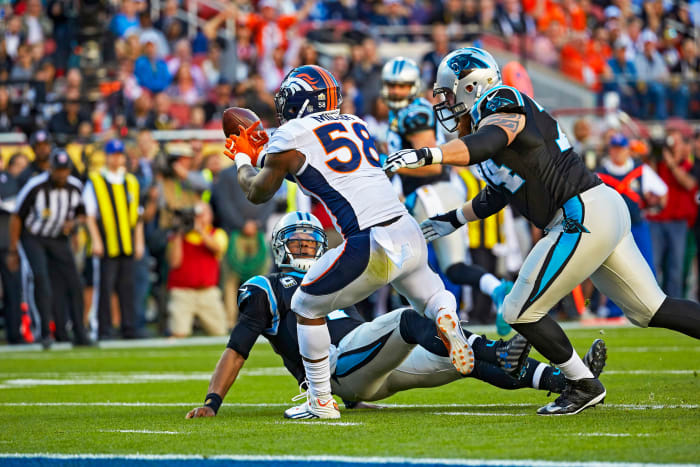
Miller's dominant performance in Super Bowl 50 earned him the game's MVP honors.
Jed Jacobsohn/Sports Illustrated
Football started to feel like 2015 right then. Stafford wasn’t as old as Manning in the Denver days, but he wanted the same thing, a ring. The Rams couldn’t boast of a secondary comparable to the Broncos’ celebrated “No Fly Zone,” but they had Ramsey, the NFL’s preeminent don’t-try corner. Miller would play alongside a future Hall of Famer in Donald, just like he had with another future Hall of Famer in Ware.
Everything seemed to align perfectly. Three times in Miller’s career he had sensed a larger force at work, something he couldn’t quite explain but could sense on the horizon: before the draft, before the championship season and in November, after the trade. “I mean, I could have been sent to Jacksonville,” he says, in way of explanation. So Miller upped the urgency, reminding the Rams “how fast these moments come and go,” and how “great teams live in eternity” but are taken apart far faster than they’re created.
Eventually, he realized: He had become Ware. Miller called his mentor from his new meeting room to share the news, thanking Ware profusely for everything but especially for what Ware drilled into him, the notion that he could become one of the best players in NFL history.
He just needed to put everything together, one last time. (Or two or three last times.)
Could he? It didn’t appear that way, at first. Miller didn’t dress until Week 10, and the Rams lost their first two games with him in uniform, portending not another run but a disastrous experiment. Still, Miller noticed that Rams did not double down when they were scuttling; they clung to the same process, tweaking based on minor revisions, not panic. The “football gods” would handle the rest.
On the night Miller planned to attend a Kanye-Drake concert at Memorial Coliseum in December, his mom called. Gloria asked, right off the bat, “Are you sitting down?” Her son was lying down, actually, receiving treatment, when Gloria told him, “DT just passed away.”
“Totally wrecked me,” Miller says. “I get chills even thinking about it.”
DT, of course, was Demaryius Thomas, like Miller and Ware, a Broncos legend. To Miller, though, Thomas was much more: teammate, brother, travel companion, confidant and inspiration. Early in his career, Thomas had urged Miller to be less humble, more urgent, to “talk his s—” and take over games the way he did in Super Bowl 50. Miller had last seen Thomas at Manning’s induction into the Pro Football Hall of Fame last summer. Thomas had told Miller he was on the verge of something big, yet again. “Like real f------ love,” Miller says.
“What happened?” he asked his mom.
Gloria told him what she knew: Thomas’s family believed he had suffered a seizure in the shower. He would have turned 34 on Christmas. Thomas’s family also wanted Miller to break the news to their Broncos brotherhood. He called Manning, Aqib Talib, Chris Harris and at least a dozen others, delivering the worst possible news over and over again, through sobs and tears, laughter and stories.
In a twist Miller never anticipated, his former teammate’s death made him closer with his new team. “Stop wasting time,” he told them, and himself. “You never know what’s going to happen. You never know when it’s going to be the ‘last few weeks’ we spend together.”
“It’s the only thing that keeps me from just going into this sad f------ space,” he says.
Worse yet, Miller couldn’t attend the funeral in person, because he had contracted COVID-19. He watched the tributes—so, so many tributes, from all over the NFL and the wider world—on a laptop screen. He looked over at his son, 3-month-old Valor, born mere days after the last time he saw Thomas, and resolved to shape the boy into the man that Thomas was. Perhaps he could become that kind of man himself.
Thomas died on Dec. 9. The Rams have lost only once since, in the regular-season finale to—who else?—the 49ers. They integrated better because of Miller, the progress he made in losing seasons, his emphasis on recovery, his grief and, in a wider sense, because of those summits he founded in 2017. Now, all sorts of NFL stars gather with their counterparts to give tips and work on their shared craft. But Miller believes his summit was the first. It’s part of a globalization of football borne from passing camps and scouting combines, with stars across the league now increasingly familiar with one another, their rivalries friendlier and less pronounced. When they switch teams in, say, midseason, the familiarity gleaned from that globalization and those summits makes it easier to find cohesion faster.
Which is exactly what happened with the Rams. Smith, the pass-rush guru, reminded Miller that he was playing on a new defense, requiring different angles and approaches to the blockers trying to minimize his impact. Donald swallowed double teams, his chemistry with Miller fortified from the extra time they spent together. Ramsey blanketed top wideouts, gifting extra time to the formidable four-man rush. Once that happened, the results Miller expected followed. In the final four regular-season games, he notched five sacks and eight QB hits, then added a sack and a QB hit in each postseason victory. “His drop-off was overblown, part of a superstar effect and expectations,” Smith says. “Man, please! It’s like when Kevin Durant said, ‘I’m KD.’ He’s Von Miller, one of the most-skilled pass rushers of all time.”
The Cardinals felt that in a wild-card trampling. So did Brady—always, Brady—and the Bucs one week later. Miller admits he felt more nervous this time, in the playoffs, after all the losing and the newfound understanding of how few opportunities he might have left. But don’t mistake the urgency to mean that Miller can see the end of his career. Brady’s lip, which Miller split open, was a bloody reminder of how much force remains.
Miller wants to re-sign with the Rams after this season. Wants to laugh with Beckham—who is on a one-year deal—about “how crazy it is that we’re on the same team.” Wants younger teammates to bound up to him in the locker room, as one did last Sunday, and tell him the same thing he told Ware: I see what you were saying.
The move, as Miller likes to frame it, “does not suck.” Because he’s back, like, as Drake might say, he “never left.” Because he wants to play until 40 and take a run at Bruce Smith’s all-time record of 200 careers sacks (Miller is currently 31st on that list, with 115½, and would need to average 11 sacks for the next eight seasons to have a realistic chance.) Because it feels like 2015, and because of who he’s playing for—his family, mentors, son and trainers; Stafford, Donald, Ramsey and his teammates; Ware and those he left behind in Denver.
Mostly, though, he will play for, will honor, Thomas. He will wear an 88 decal on his helmet and don T-shirts with Thomas’s likeness for postgame news conferences. And he will hope that he can do for Thomas what Elway did for Pat Bowlen, the Broncos’ owner who couldn’t travel to Super Bowl 50 and died in 2019. After Denver’s triumph, Elway held the Lombardi Trophy high and yelled, “This one’s for Pat!”
Miller, of course, dreamed up a similar scenario in recent weeks. He plans to do the same, only he’ll yell, “This one’s for DT!”
More NFL Coverage:
• Cooper Kupp’s Scientific Approach to Greatness
• Thirteen Seconds: Mahomes, Chiefs Win an Instant Classic
• Joe Burrow’s Rise, Through the Eyes of His Parents
• The Meaning of a Ring for the Four Remaining Quarterbacks

































